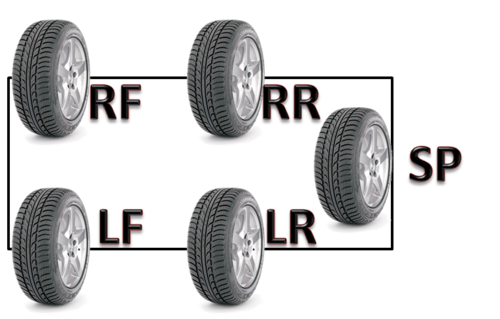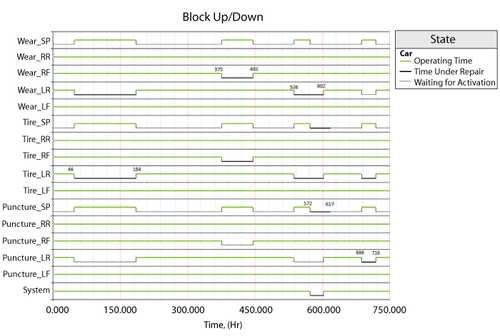Template:Tires: Difference between revisions
Jump to navigation
Jump to search
| Line 37: | Line 37: | ||
#In the Car diagram, there are five subdiagram blocks Tire_1, Tire_2, Tire_3, Tire_4 and Spare (each referencing/pointing to the five diagrams with the same names). | #In the Car diagram, there are five subdiagram blocks Tire_1, Tire_2, Tire_3, Tire_4 and Spare (each referencing/pointing to the five diagrams with the same names). | ||
##In diagram Car, subdiagram blocks Tire_1, Tire_2, Tire_3 and Tire_4 belong to maintenance group "Main Tires". | ##In diagram Car, subdiagram blocks Tire_1, Tire_2, Tire_3 and Tire_4 belong to maintenance group "Main Tires". | ||
[[Image:Car.png|thumb|center|500px|BlockSim 8 Diagrams]] | [[Image:Car.png|thumb|center|500px|BlockSim 8 Diagrams]] | ||
Revision as of 14:19, 24 July 2011
Tire Example
Consider a car with four regular tires (RF, LF, RR, LR) and a spare tire (SP). Furthermore assume that each tire can fail based on two failure modes, wear and puncture, and:
- The wear failure modes follows a Weibull distribution with Beta = 1.5, Eta = 600 hours.
- The puncture failure mode folllows an exponential distribution with a mean of 2 months.
- Regardless of the failure mode, the repair duration (of both wear and puncture) follows a Weibull distribution with Beta = 1.5,Eta = 100 hours.
- If the tire fails due to wear the tire is replaced with a new one (wear is repaired as-good-as-new).
- If the tire fails due to a puncture, it is patched up and placed biack into service (repaired as-bad-as-old).
- When a primary tire (RF, LF, RR or LR) fails it is replaced with the spare (SP) until that tire is restored. Once restored the tire is put back in it's original postion and the spare is removed and put back for later use.
Purposes
The purpose of this example is to illustrate the following options in SCT:
- State Upon Repair: Always ON, Always OFF
- Activate a block if any item from these associated maintenance group(s) goes down.
- Deactivate a block if any item from these associated maintenance group(s) is restored.
- Deactivate a block if any item from these associated maintenance group(s) goes down.
- Activate a block if any item from these associated maintenance group(s) is restored.
BlockSim Solution
- To model this system, six diagrams are created: Car, Tire_1, Tire_2, Tire_3, Tire_4 and Spare with Car being the main diagram. Create the diagrams as follows:
- First create diagram Tire_1 with two blocks in series. Block Wear 1 represents Wear failure mode and Puncture 1 represents Puncture failure mode for tire 1 respectively.
- Block Wear 1 belongs to maintenance group "Wear_1" and Block Puncture 1 belongs to maintenance group "Puncture_1".
- Block Wear 1 has State Change Triggers (SCT), its initial state is ON, and the state upon repair is "Always On". If any item from maintenance group "Puncture_1" goes down, deactivate this block and if any item from maintenance group "Puncture_1" is restored, activate this block.
- Block Puncture 1 also has State Change Triggers (SCT), its initial state is ON, and the state upon repair is "Always On". If any item from maintenance group "Wear_1" goes down, deactivate this block and if any item from maintenance group "Wear_1" is restored, activate this block.
- Create the other three diagrams (Tire_2, Tire_3 and Tire_4) following the same logic.
- In diagram Spare, there are two blocks in series. Block Wear_S represents Wear failure mode and Puncture_S represents Puncture failure mode for spare tire respectively. Block Wear_S belongs to maintenance group "Wear_S" and Block Puncture_S belongs to maintenance group "Puncture_S".
- Block Wear_S has State Change Triggers (SCT), its initial state is OFF, and the state upon repair is "Always OFF". If any item from maintenance group "Puncture_S" goes down, deactivate this block and if any item from maintenance group "Puncture_S" is restored, activate this block. If any item from maintenance group "Main Tires" goes down, activate this block and if any item from the maintenance group "Main Tires" is restored, deactivate this block.
- Block Puncture_S has State Change Triggers (SCT), its initial state is OFF, and the state upon repair is "Always OFF". If any item from maintenance group "Wear_S" goes down, deactivate this block and if any item from maintenance group "Wear_S" is restored, activate this block. If any item from maintenance group "Main Tires" goes down, activate this block and if any item from the maintenance group "Main Tires" is restored, deactivate this block.
- In the Car diagram, there are five subdiagram blocks Tire_1, Tire_2, Tire_3, Tire_4 and Spare (each referencing/pointing to the five diagrams with the same names).
- In diagram Car, subdiagram blocks Tire_1, Tire_2, Tire_3 and Tire_4 belong to maintenance group "Main Tires".
Blocks Up/Down plot
The system event log is shown in Figure below and is as follows (only blocks have failures are plot):
- At 91, Block Puncture 2 fails and brings down subdiagram Tire_2. At the same time, it turns Block Wear 2 OFF. Subdiagram Tire_2 goes down and actives Block Wear_S and Puncture_S, and subdiagram Spare is turn ON too.
- At 253, Block Puncture 2 is done with repair. According to setting, it is always ON upon repair (is restored). The restoration of Block Puncture 2 activates Block Wear 2 and thus subdiagram Tire_2 is ON. The restoration of subdiagram Tire_2 deactives Block Wear_S and Puncture_S, and subdiagram Spare is turn OFF too.
- At 427, Block Puncture 2 fails again and brings down subdiagram Tire_2. At the same time, it turns Block Wear 2 OFF. Subdiagram Tire_2 goes down and actives Block Wear_S and Puncture_S, and subdiagram Spare is turn ON too.
- At 442, Block Wear_S fails and brings down subdiagram Spare. At the same time, it turns Block Puncture_S (file crashed, to be continous later)


